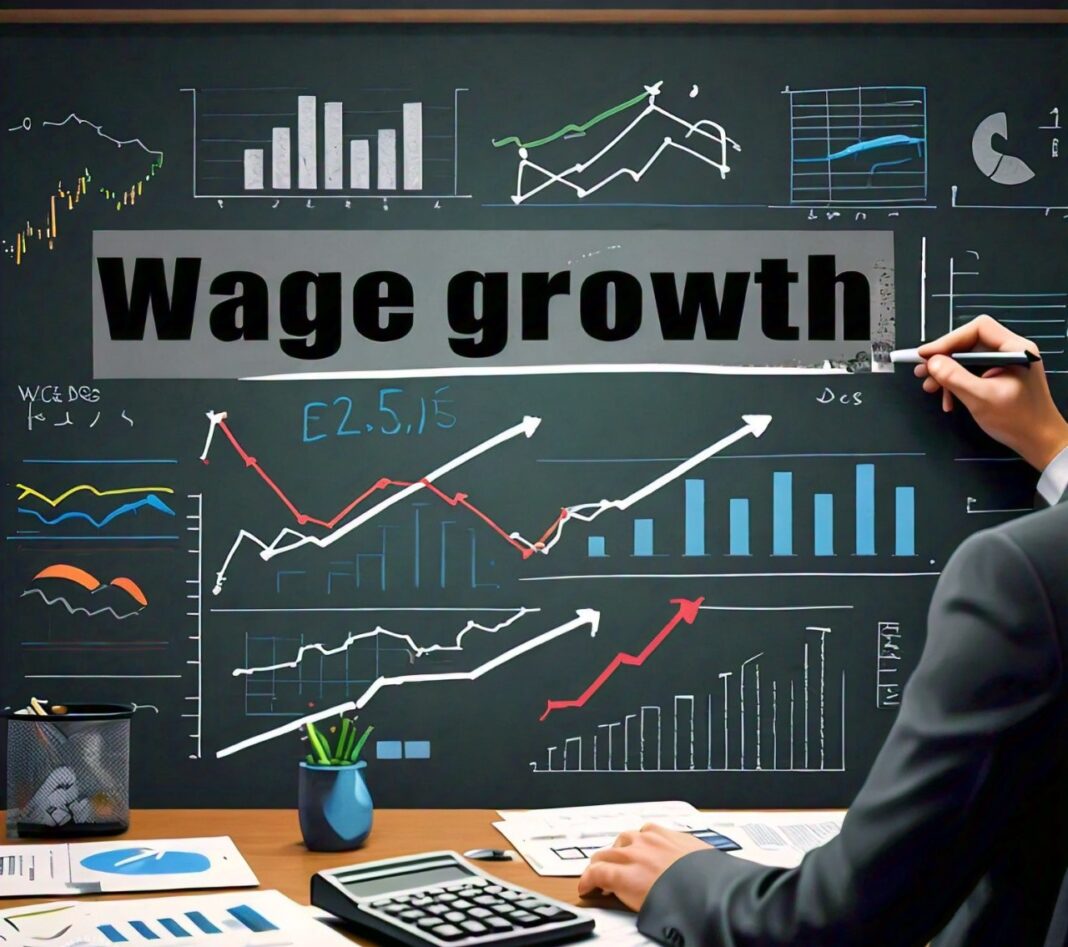Wage growth is a critical economic metric that reflects changes in the compensation of employees over time. It not only signifies improvements in individual financial well-being but also serves as a barometer for broader economic conditions. When wages increase, it typically indicates rising demand for labor, suggesting a strengthening economy. Conversely, stagnant or declining wages can signal economic distress and labor market challenges.
Understanding wage growth as an economic indicator is essential for economists and analysts who seek to assess the health of the economy and labor market dynamics. By examining wage trends, these professionals can glean insights into consumer spending patterns, inflation pressures, and overall economic stability. Historically, wage growth has been linked to various economic outcomes, making it a focal point for policy discussions, business strategies, and academic research.
This article delves into the multifaceted role of wage growth as an indicator of economic health, exploring its correlations with other key economic indicators, the factors influencing wage changes, and its predictive capabilities for future economic trends. By comprehensively understanding wage growth, economists and analysts can better interpret labor market signals and contribute to informed decision-making in both public policy and corporate strategy.
The Role of Wage Growth in Economic Indicators
Wage growth is one of the key economic indicators that provides valuable insights into the overall health of an economy. Economic indicators are statistics that provide information about economic performance and trends, helping economists, analysts, and policymakers make informed decisions. Among these indicators, wage growth holds a unique position due to its direct impact on consumer behavior and economic activity.
Explanation of Economic Indicators
Economic indicators can be classified into three categories: leading, lagging, and coincident indicators. Each type serves a distinct purpose in economic analysis:
- Leading Indicators: These indicators predict future economic activity. Wage growth can sometimes serve as a leading indicator when it reflects anticipated increases in consumer spending.
- Lagging Indicators: These indicators confirm trends after they have occurred. Wage growth can also act as a lagging indicator, reflecting the effects of economic policies or market conditions that have already taken place.
- Coincident Indicators: These indicators move in line with the economy. Wage growth often aligns with overall economic performance, making it a coincident indicator as well.
Position of Wage Growth Among Key Economic Indicators
Wage growth is often analyzed alongside other significant economic indicators such as Gross Domestic Product (GDP), unemployment rates, and inflation. For instance, when GDP grows, it often correlates with rising wages, as businesses experience higher revenues and can afford to pay employees more. Conversely, high unemployment rates typically lead to stagnant wage growth, as labor supply exceeds demand.

Historical Context: How Wage Growth Has Been Used in Past Economic Analyses
Historically, wage growth has played a pivotal role in economic analyses. For example, during the post-World War II boom, wage increases were a sign of robust economic growth and rising living standards. In contrast, during periods of economic recession, such as the Great Depression or the 2008 financial crisis, wage stagnation or decline highlighted the struggles faced by workers and the economy at large.
One relevant key phrase that encapsulates this section is “Wage growth trends and economic stability.” Understanding how wage growth interacts with various economic factors provides economists and analysts with a clearer picture of economic stability.
The Relationship Between Wage Growth and Economic Health
Wage growth is intricately linked to various aspects of economic health, influencing and reflecting the overall performance of the economy. Understanding this relationship can provide valuable insights for economists and analysts seeking to assess labor market conditions and predict future economic trends.
Overview of Economic Health Indicators
Economic health is typically assessed through a set of key indicators, including:
- Gross Domestic Product (GDP): A measure of the total economic output of a country. Rising GDP often correlates with improved wage growth, as businesses expand and require more labor.
- Unemployment Rates: The percentage of the labor force that is unemployed but actively seeking work. High unemployment usually suppresses wage growth, as job seekers compete for limited positions.
- Consumer Spending: As wages increase, consumer spending tends to rise, driving economic growth. This relationship shows how wage growth can lead to improved economic conditions.
Correlation Between Wage Growth and These Indicators
Research indicates a strong correlation between wage growth and economic health indicators. For example, when unemployment rates are low, companies often compete for workers by raising wages, which in turn boosts consumer spending. Conversely, during economic downturns, wage growth tends to stagnate or decline, reflecting reduced business revenues and lower consumer confidence.
A notable study published by the National Bureau of Economic Research highlights this correlation, showing that wage growth can be a lagging indicator, often responding to improvements in GDP and declines in unemployment after the fact.
Factors Influencing Wage Growth
Wage growth is influenced by a myriad of factors that intersect with labor market conditions, economic policies, and broader economic trends. Understanding these factors is crucial for economists and analysts as they seek to interpret wage changes and their implications for economic health.
Labor Market Conditions
Supply and Demand for Labor
The most fundamental factor influencing wage growth is the supply and demand for labor. When demand for workers exceeds supply, employers are often compelled to raise wages to attract and retain talent. Conversely, when there is an oversupply of labor, such as during economic downturns, wage growth tends to stagnate.
Also Read: Why Employment Data is a Critical Economic Indicator
Skills Gap and Education
The skills and education levels of the workforce also play a critical role. Industries requiring specialized skills often see faster wage growth due to competition for qualified workers. As technological advancements continue to reshape the job market, a mismatch between the skills of available workers and the needs of employers can lead to wage disparities across sectors.
Inflation and Cost of Living
Wage growth must also be considered in the context of inflation and the cost of living. If wages rise but inflation outpaces those increases, workers may find their purchasing power diminished. Therefore, real wage growth, which adjusts for inflation, is a more accurate measure of economic well-being. Analysts often focus on real wage growth to get a clearer picture of how wage changes affect consumers.
Government Policies and Regulations
Minimum Wage Laws
Government policies, particularly those related to minimum wage laws, have a direct impact on wage growth. Increases in the minimum wage can lift earnings for low-wage workers, but they can also prompt businesses to adjust their hiring practices or pass costs onto consumers, affecting broader wage trends.
Tax Policies
Tax policies can influence disposable income and, consequently, wage growth. Tax cuts for individuals can lead to increased consumer spending, which may prompt businesses to increase wages to meet heightened demand. Conversely, higher taxes can constrain spending and slow wage growth.

Global Economic Factors
Trade Agreements
Globalization and trade agreements also play a role in wage growth. As companies expand their operations internationally, they may face increased competition, which can pressure them to keep wages low. However, successful trade agreements can open new markets for businesses, potentially leading to increased demand for labor and higher wages.
Economic Globalization
The interconnectedness of global economies means that wage trends in one country can affect those in another. For example, outsourcing and offshoring can lead to wage stagnation in domestic markets as companies seek lower labor costs abroad. Conversely, a booming global economy can create demand for domestic labor, driving wage growth.
Also Read: The Influence of Globalization In Emerging Markets
Wage Growth as a Predictor of Future Economic Trends
Wage growth is not only a reflection of current economic conditions but also serves as a significant predictor of future economic trends. Understanding this predictive capability is crucial for economists and analysts aiming to anticipate shifts in the economy and labor market dynamics.
Predictive Capabilities of Wage Growth
Wage growth can signal future economic activity in several ways:
- Consumer Spending: Increased wages typically lead to higher consumer spending, which drives economic growth. As consumers have more disposable income, they are likely to spend on goods and services, stimulating demand and encouraging businesses to invest in expansion.
- Investment Decisions: Businesses often look at wage growth trends when making investment decisions. Rising wages can indicate a strong labor market, prompting companies to invest in new projects, hire additional staff, or expand operations. Conversely, stagnant wages may lead to cautious investment strategies.
- Inflationary Pressures: Wage growth can also indicate potential inflationary pressures. If wages rise too quickly, it can lead to increased costs for businesses, which may then pass those costs onto consumers through higher prices. Economists monitor wage growth closely as part of their inflation forecasts.
Limitations and Challenges in Using Wage Growth as a Predictor
While wage growth can provide important insights, there are limitations and challenges to consider:
- Lagging Indicator: Wage growth is often a lagging indicator, meaning it may not reflect immediate economic conditions. By the time wage growth begins to rise, the economy may already be in recovery or decline.
- Regional Variations: Wage growth can vary significantly by region and industry. Analysts must consider local economic conditions when interpreting wage trends, as national averages may obscure important regional differences.
- External Shocks: Economic shocks, such as natural disasters or geopolitical events, can disrupt wage trends. Analysts must account for these factors when using wage growth to predict future economic conditions.
Implications for Policymakers and Businesses
Understanding wage growth as an economic indicator has significant implications for both policymakers and businesses. By recognizing the factors that drive wage changes and their impact on the economy, these stakeholders can make informed decisions that promote sustainable growth and improve labor market conditions.
Importance for Economic Policy Formulation
Policymakers play a crucial role in shaping the economic landscape, and insights into wage growth can inform various policy decisions:
- Minimum Wage Legislation: Discussions around raising the minimum wage are often grounded in the need for living wages. Policymakers must consider the potential impacts on wage growth across different sectors. While increasing the minimum wage can uplift low-income workers, it may also lead to higher unemployment in certain industries if businesses cannot absorb the increased labor costs.
- Tax and Fiscal Policies: Policymakers can use wage growth trends to guide tax and fiscal policies. For instance, if wage growth is robust, it may indicate a thriving economy that could support tax reforms aimed at increasing funding for public services. Conversely, stagnant wages may prompt calls for tax relief to stimulate consumer spending.
- Workforce Development Programs: Understanding the relationship between wage growth and skills development can inform workforce training programs. Policymakers can invest in education and vocational training initiatives that align with the skills in demand, ensuring that the workforce is equipped to meet the needs of evolving industries.
Also Read: How Government Spending Influences Economic Indicator
Impacts on Business Strategy and Workforce Management
Businesses must also pay close attention to wage growth trends as they develop strategies to attract and retain talent:
- Compensation Strategies: Companies often adjust their compensation packages in response to wage trends. In a competitive labor market, businesses may need to offer higher salaries, better benefits, or flexible working conditions to attract top talent. Monitoring wage growth can help identify when such adjustments are necessary.
- Talent Retention: High wage growth can signal a tight labor market, prompting businesses to invest in employee retention strategies. This may include professional development opportunities, enhanced workplace culture, and competitive benefits packages that address employee needs and preferences.
- Investment in Automation: In industries facing rising labor costs, businesses may consider investing in automation as a means to maintain profitability. Understanding wage growth trends can help companies determine the right balance between labor and technology investments.
Also Read: Why Employment Data is a critical Economic Indicator

Recommendations for Leveraging Wage Growth Data
To effectively leverage wage growth data, both policymakers and businesses should consider the following recommendations:
- Regular Data Analysis: Continuous monitoring of wage growth data, along with other economic indicators, can provide timely insights into labor market conditions. Utilizing platforms like the Bureau of Labor Statistics or the Federal Reserve Economic Data (FRED) can help stakeholders stay informed.
- Collaboration with Economic Experts: Engaging with economists and analysts can enhance understanding of wage trends and their implications. Collaborative efforts can lead to more effective policies and business strategies that promote economic stability.
- Focus on Inclusive Growth: Ensuring that wage growth benefits a broad range of workers is crucial for sustainable economic development. Policymakers and businesses should prioritize strategies that promote equitable wage increases, addressing disparities across different demographic groups and industries.
Conclusion
Wage growth serves as a vital economic indicator that encapsulates the health of the labor market and the broader economy. Throughout this article, we have explored the multifaceted role of wage growth, including its correlation with key economic indicators, the factors influencing its trends, and its predictive capabilities for future economic conditions.
As the economy continues to evolve, ongoing research and analysis of wage growth will remain essential. Stakeholders are encouraged to leverage available data sources and collaborate with economic experts to deepen their understanding of wage trends and their broader implications. By doing so, they can contribute to a more informed economic discourse and develop strategies that address the challenges and opportunities presented by wage growth.
For those interested in further exploring the dynamics of wage growth and its implications, resources like the National Bureau of Economic Research and the Economic Policy Institute offer valuable research and insights.






